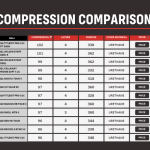To hit down on a golf ball, focus on striking the ball before the ground. Maintain a descending clubhead path through impact.
Golfers often struggle with achieving the perfect downward strike on the ball. Hitting down ensures solid contact and optimal ball flight. Proper technique involves maintaining a correct stance, positioning the ball slightly back in your stance, and ensuring your hands lead through impact.
This approach helps compress the ball against the turf, generating more spin and control. Practicing this method can significantly improve your game, leading to better consistency and lower scores. Focus on these fundamentals, and you’ll notice a marked improvement in your ball striking and overall performance on the course.
Importance Of Hitting Down
Hitting down on a golf ball is crucial for improving your game. This technique helps you gain better control and precision. It also ensures a more consistent ball flight and better distance.
Why It Matters
Understanding why hitting down is important can transform your golf game. Here are some key reasons:
- Improved Control: Hitting down helps you control the ball better.
- Consistent Ball Flight: This technique leads to more consistent shots.
- Better Distance: Proper contact ensures the ball travels further.
When you hit down, you compress the ball against the turf. This compression creates backspin, which helps the ball fly higher and stop quicker on the greens.
Common Misconceptions
Many golfers misunderstand the concept of hitting down. Let’s clear up some common misconceptions:
| Misconception | Reality |
|---|---|
| Hitting Down Means Swinging Harder | In fact, it’s about technique, not force. |
| Hitting Down Can Hurt Your Clubs | Proper technique will protect your clubs and improve your game. |
| Hitting Down Is Only for Advanced Players | Every golfer, beginner to pro, should learn this technique. |
By understanding and correcting these misconceptions, you can improve your swing. Practice hitting down to see real improvements in your game.

Credit: meandmygolf.com
Proper Stance And Alignment
Learning how to hit down on a golf ball requires a solid stance. Proper alignment helps you achieve consistent and powerful shots. This section covers the essentials of foot positioning, hip, and shoulder alignment. These elements are crucial for a successful golf swing.
Feet Position
Your feet should be shoulder-width apart. This helps you maintain balance. Place your lead foot slightly open. This promotes a better follow-through. Your trail foot should be perpendicular to the target line. This setup stabilizes your base and enhances swing consistency.
Hip And Shoulder Alignment
Align your hips and shoulders parallel to the target line. This ensures a straight swing path. Your lead hip should be slightly higher than your trail hip. This encourages a downward strike on the ball. Keep your shoulders square. This promotes accuracy and power.
| Element | Position | Purpose |
|---|---|---|
| Feet | Shoulder-width apart | Maintain balance |
| Lead Foot | Slightly open | Better follow-through |
| Trail Foot | Perpendicular to target | Stabilize base |
| Hips | Parallel to target line | Straight swing path |
| Lead Hip | Slightly higher | Downward strike |
| Shoulders | Square | Accuracy and power |
By mastering your stance and alignment, hitting down on the ball becomes easier. Practice these steps to improve your golf game.
Grip And Hand Position
Understanding the grip and hand position is vital for striking a golf ball effectively. A proper grip and correct hand placement enable better control. This helps you hit down on the ball with precision. Let’s explore the correct grip and hand placement techniques.
Correct Grip
The grip is your connection to the golf club. A correct grip helps you maintain control and power. There are three common types of grips:
- Vardon Overlap – The pinky finger of the trailing hand rests on top of the index finger of the lead hand.
- Interlocking Grip – The pinky finger of the trailing hand interlocks with the index finger of the lead hand.
- Ten-Finger Grip – All ten fingers are on the club, similar to holding a baseball bat.
Choose a grip that feels comfortable and secure for you. Ensure your grip is neither too tight nor too loose. A balanced grip provides better control and power.
Hand Placement
Hand placement on the club is crucial for hitting down on the ball. Follow these steps for proper hand placement:
- Place the club in your lead hand. Ensure the club runs diagonally across your palm.
- Wrap your fingers around the club. Your thumb should point down the shaft.
- Place your trailing hand on the club. The lifeline of your trailing hand should cover the thumb of your lead hand.
- Ensure both thumbs are pointing down the shaft of the club.
Proper hand placement ensures that the clubface remains square. This allows you to hit down on the ball effectively. Always check your hand placement before each swing.

Credit: www.adamyounggolf.com
Backswing Fundamentals
Understanding the backswing fundamentals is crucial for hitting down on a golf ball. A proper backswing sets the foundation for a powerful and accurate shot. Mastering these basics will improve your overall game.
Starting The Swing
The beginning of the swing is critical. Start with a solid stance. Your feet should be shoulder-width apart. Bend your knees slightly. Keep your back straight.
Hold the club firmly but not too tight. Your grip should feel natural. Imagine you’re holding a small bird. You don’t want to crush it, but you don’t want it to fly away either.
As you start the swing, rotate your shoulders. Your hips should follow naturally. Keep your head still and your eyes on the ball. This will help maintain focus and control.
Maintaining Control
During the backswing, maintain control to ensure accuracy. Keep your arms straight but relaxed. Your left arm should be straight if you’re a right-handed golfer.
Focus on a smooth, fluid motion. Avoid jerky or rushed movements. This helps in maintaining balance and power.
As you reach the top of the backswing, pause briefly. This pause helps you gather energy for the downswing. It also helps you stay in control of the club.
Remember, a controlled backswing leads to a powerful downswing. Practice these steps regularly. You’ll see improvements in your game.
Executing The Downswing
Executing the downswing in golf is crucial for hitting down on the ball. A well-executed downswing ensures solid contact and optimal ball flight. Let’s break down the key elements: weight transfer and club path.
Weight Transfer
Proper weight transfer is vital for a powerful downswing. Start with your weight evenly distributed. As you begin the downswing, shift your weight to your front foot. This movement generates power and stability.
- Start with a balanced stance.
- Shift weight to your front foot during the downswing.
- Feel the pressure on your front foot upon impact.
Club Path
The club path dictates the quality of your shot. Your club should move from inside the target line. This inside-out path promotes solid contact and a straight shot.
- Keep the club on the inside path.
- Avoid an outside-in swing path.
- Practice to ensure a consistent inside-out path.
Combining proper weight transfer and a correct club path helps achieve a powerful downswing. Focus on these elements to improve your golf game.

Credit: m.youtube.com
Impact And Follow-through
Understanding the impact and follow-through in golf is crucial. These elements determine how well you hit down on the golf ball. This section focuses on two key aspects: striking the ball and finishing the swing.
Striking The Ball
Striking the golf ball correctly requires precision. Position the ball in the middle of your stance. Ensure your hands are slightly ahead of the ball at address. This helps you create a downward strike.
Focus on making contact with the ball first. Then, let the clubhead hit the ground. This technique produces a clean shot and compresses the ball. A compressed ball travels farther and straighter.
Using a descending blow is important. Practice hitting down on the ball during your swings. You’ll notice improved consistency and control.
Finishing The Swing
Finishing the swing correctly is essential. After striking the ball, follow through fully. Your club should continue its path to a high finish.
Ensure your body weight shifts to your front foot. This movement helps maintain balance and power. Your chest should face the target. This position indicates a full, proper follow-through.
Maintain a relaxed grip throughout the swing. Tension can hinder your ability to finish strong. A relaxed grip allows for a smooth, natural motion.
| Key Points | Tips |
|---|---|
| Striking the Ball | Position ball in the middle, hands ahead, use descending blow |
| Finishing the Swing | Full follow-through, weight on front foot, relaxed grip |
Drills To Improve Technique
Hitting down on a golf ball is crucial for crisp, accurate shots. Improving this skill requires specific drills. These drills can help you perfect your swing, balance, and impact. Let’s explore some effective ways to improve your technique.
Practice Drills
Practice drills focus on muscle memory and precision. Here are some effective drills:
- Divot Drill: Set up a line of balls. Aim to hit the ground just after the ball. This helps ensure you’re hitting down on the ball.
- Impact Bag Drill: Use an impact bag to practice your down-swing. Strike the bag with a downward motion. This helps build the right feel and power.
- Alignment Stick Drill: Place an alignment stick a few inches behind the ball. Avoid hitting the stick. This drill encourages a clean, downward strike on the ball.
Training Aids
Training aids can accelerate your improvement. These tools guide your swing and impact. Here are some recommended aids:
| Training Aid | Purpose |
|---|---|
| Alignment Sticks | Help with swing path and target alignment. |
| Impact Bag | Builds muscle memory for the correct impact position. |
| Weighted Clubs | Strengthens muscles used during the golf swing. |
Incorporating these drills and aids can significantly improve your game. Practice consistently to see the best results.
Common Mistakes To Avoid
Hitting down on a golf ball is a skill many golfers aim to master. But, many common mistakes can hinder progress. Understanding these mistakes helps improve your swing and overall game. Here are some common mistakes to avoid.
Overcompensating
Overcompensating often occurs when golfers try too hard to hit down. This leads to excessive force and improper form. You might dip your shoulder too much. This can result in a fat shot or a missed shot.
Another sign of overcompensating is a steep swing path. This can cause the club to dig into the ground. Instead, focus on maintaining a smooth, controlled swing. Use your body rotation to generate power.
A balanced approach prevents overcompensation. Keep your swing natural and fluid. This ensures better contact with the ball.
Incorrect Timing
Timing is crucial in hitting down on the golf ball. Many golfers struggle with this aspect. Early or late swings can lead to poor shots. Early swings make you hit the ground before the ball. This results in a loss of power and accuracy.
Late swings can cause you to hit the ball too high. This reduces control and precision. To achieve correct timing, practice the rhythm of your swing. Focus on the moment when your clubhead meets the ball.
Consider using a metronome during practice. This helps you find the right tempo. Consistent timing leads to better ball striking.
Summary Table Of Common Mistakes
| Mistake | Description |
|---|---|
| Overcompensating | Excessive force and steep swing path |
| Incorrect Timing | Early or late swings affecting accuracy |
By avoiding these common mistakes, you can improve your golf game. Practice with patience and focus on the fundamentals. This will help you hit down on the golf ball more effectively.
Frequently Asked Questions
How Do You Hit Down And Compress A Golf Ball?
To hit down and compress a golf ball, keep your weight forward. Strike the ball before the ground, maintaining a descending blow. Use a forward shaft lean at impact for better compression.
How To Hit A Golf Ball First Then Divot?
Position the ball slightly back in your stance. Keep your weight forward. Swing down and through, striking the ball first.
How Do You Hit A Golf Ball On A Downward Slope?
To hit a golf ball on a downward slope, position the ball back in your stance. Align your shoulders with the slope. Swing smoothly, maintaining balance and follow through. Use a club with more loft to help lift the ball.
How To Hit A Fade Every Time?
To hit a fade every time, align your body left of the target. Open the clubface slightly. Swing along your body line. Keep your hands quiet. Practice consistently for accuracy.
Conclusion
Mastering the technique to hit down on a golf ball can transform your game. Practice consistently, focus on your form, and stay patient. These tips will help improve your swing and accuracy. Remember, dedication and practice are key to becoming a better golfer.
Enjoy the process and watch your skills grow.





